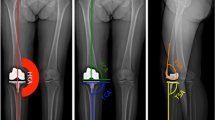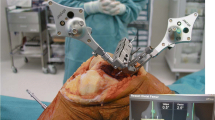Abstract
Purpose
Patient-specific guides have been introduced recently as a means of making accurate bone cuts through custom cutting blocks constructed based on pre-operative three-dimensional imaging. However, the controversy concerning the improved results of patient-specific guides have not been resolved yet; in addition, there have been no studies to investigate the causes of variable with inconsistent results and solutions for the causes.
Methods
Thirty eight patients (38 knees) underwent total knee arthroplasty with patient-specific guides. The mean age of the patients was 68 years (SD ± 6.3), and all patients had a minimum 2-year follow-up. An intra-operative alignment using navigation and the causes of outliers were evaluated.
Results
An average coronal alignment of PSI jigs was 0.5° (SD ± 0.9°) in femur and 0.1° (SD ± 0.8°) in tibia, and the number of outliers was two and three cases, respectively. An average sagittal alignment was 0.6° (SD ± 0.9°) in femur and 5.5° (SD ± 1.1°) in tibia, and the number of outliers was three and five cases, respectively. All outliers resulted from large osteophytes near the contact point of patient-specific guides which disturb sitting of the guide.
Conclusion
It was suggested that patient-specific guides were an effective and safe method to achieve accurate alignments, with no additional intra-operative complication. It is important to note that surgeons need to be precautious using the patient-specific instrumentation in patients with severe varus deformity. In addition, existing osteophytes which disturb sitting of the guides should be carefully evaluated pre-operatively and intra-operatively.
Level of evidence
IV.





Similar content being viewed by others
References
Barrack RL, Ruh EL, Williams BM, Ford AD, Foreman K, Nunley RM (2012) Patient specific cutting blocks are currently of no proven value. J Bone Joint Surg Br 94:95–99
Conteduca F, Iorio R, Mazza D, Caperna L, Bolle G, Argento G, Ferretti A (2013) Evaluation of the accuracy of a patient-specific instrumentation by navigation. Knee Surg Sports Traumatol Arthrosc 21:2194–2199
Hernandez-Vaquero D, Suarez-Vazquez A, Iglesias-Fernandez S (2011) Can computer assistance improve the clinical and functional scores in total knee arthroplasty? Clin Orthop Relat Res 469:3436–3442
Jenny JY, Boeri C, Picard F, Leitner F (2004) Reproducibility of intra-operative measurement of the mechanical axes of the lower limb during total knee replacement with a non-image-based navigation system. Comput Aided Surg 9:161–165
Klatt BA, Goyal N, Austin MS, Hozack WJ (2008) Custom-fit total knee arthroplasty (OtisKnee) results in malalignment. J Arthroplast 23:26–29
Lombardi AV Jr, Berend KR, Adams JB (2008) Patient-specific approach in total knee arthroplasty. Orthopedics 31:927–930
Lustig S, Fleury C, Goy D, Neyret P, Donell ST (2011) The accuracy of acquisition of an imageless computer-assisted system and its implication for knee arthroplasty. Knee 18:15–20
Lustig S, Scholes CJ, Oussedik SI, Kinzel V, Coolican MR, Parker DA (2013) Unsatisfactory accuracy as determined by computer navigation of VISIONAIRE patient-specific instrumentation for total knee arthroplasty. J Arthroplast 28:469–473
Magnussen RA, Weppe F, Demey G, Servien E, Lustig S (2011) Residual varus alignment does not compromise results of TKAs in patients with preoperative varus. Clin Orthop Relat Res 469:3443–3450
Marx RG, Grimm P, Lillemoe KA, Robertson CM, Ayeni OR, Lyman S, Bogner EA, Pavlov H (2011) Reliability of lower extremity alignment measurement using radiographs and PACS. Knee Surg Sports Traumatol Arthrosc 19:1693–1698
Mason JB, Fehring TK, Estok R, Banel D, Fahrbach K (2007) Meta-analysis of alignment outcomes in computer-assisted total knee arthroplasty surgery. J Arthroplast 22:1097–1106
Matziolis G, Krocker D, Weiss U, Tohtz S, Perka C (2007) A prospective, randomized study of computer-assisted and conventional total knee arthroplasty. Three-dimensional evaluation of implant alignment and rotation. J Bone Joint Surg Am 89:236–243
Ng VY, DeClaire JH, Berend KR, Gulick BC, Lombardi AV Jr (2012) Improved accuracy of alignment with patient-specific positioning guides compared with manual instrumentation in TKA. Clin Orthop Relat Res 470:99–107
Nunley RM, Ellison BS, Zhu J, Ruh EL, Howell SM, Barrack RL (2012) Do patient-specific guides improve coronal alignment in total knee arthroplasty? Clin Orthop Relat Res 470:895–902
Pitto RP, Graydon AJ, Bradley L, Malak SF, Walker CG, Anderson IA (2006) Accuracy of a computer-assisted navigation system for total knee replacement. J Bone Joint Surg Br 88:601–605
Scholes C, Sahni V, Lustig S, Parker DA, Coolican MR (2014) Patient-specific instrumentation for total knee arthroplasty does not match the pre-operative plan as assessed by intra-operative computer-assisted navigation. Knee Surg Sports Traumatol Arthrosc 22:660–665
Spencer BA, Mont MA, McGrath MS, Boyd B, Mitrick MF (2009) Initial experience with custom-fit total knee replacement: intra-operative events and long-leg coronal alignment. Int Orthop 33:1571–1575
Stronach BM, Pelt CE, Erickson J, Peters CL (2013) Patient-specific total knee arthroplasty required frequent surgeon-directed changes. Clin Orthop Relat Res 471:169–174
Stulberg SD, Yaffe MA, Koo SS (2006) Computer-assisted surgery versus manual total knee arthroplasty: a case-controlled study. J Bone Joint Surg Am 88(4):47–54
Thienpont E, Bellemans J, Delport H, Van Overschelde P, Stuyts B, Brabants K, Victor J (2013) Patient-specific instruments: industry’s innovation with a surgeon’s interest. Knee Surg Sports Traumatol Arthrosc 21:2227–2233
Victor J, Dujardin J, Vandenneucker H, Arnout N, Bellemans J (2014) Patient-specific guides do not improve accuracy in total knee arthroplasty: a prospective randomized controlled trial. Clin Orthop Relat Res 472:263–271
Yaffe MA, Patel A, Mc Coy BW, Luo M, Cayo M, Ghate R, Stulberg SD (2012) Component sizing in total knee arthroplasty: patient-specific guides vs. computer-assisted navigation. Biomed Tech 57:277–282
Acknowledgments
This research was supported by a Grant (CRI 12072, 2012) on the Chonnam National Hospital.
Author information
Authors and Affiliations
Corresponding author
Rights and permissions
About this article
Cite this article
Seon, JK., Park, HW., Yoo, SH. et al. Assessing the accuracy of patient-specific guides for total knee arthroplasty. Knee Surg Sports Traumatol Arthrosc 24, 3678–3683 (2016). https://doi.org/10.1007/s00167-014-3429-z
Received:
Accepted:
Published:
Issue Date:
DOI: https://doi.org/10.1007/s00167-014-3429-z




